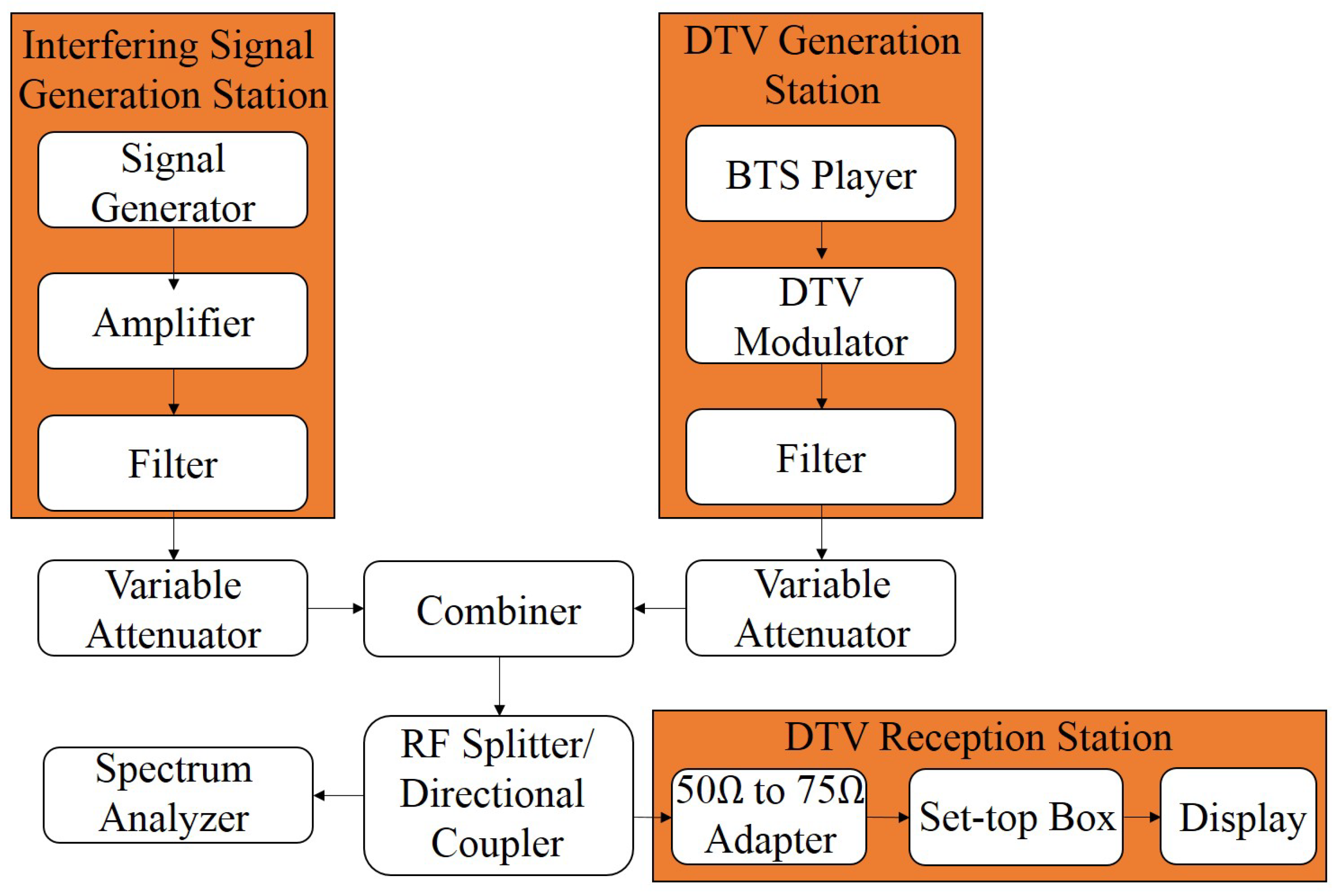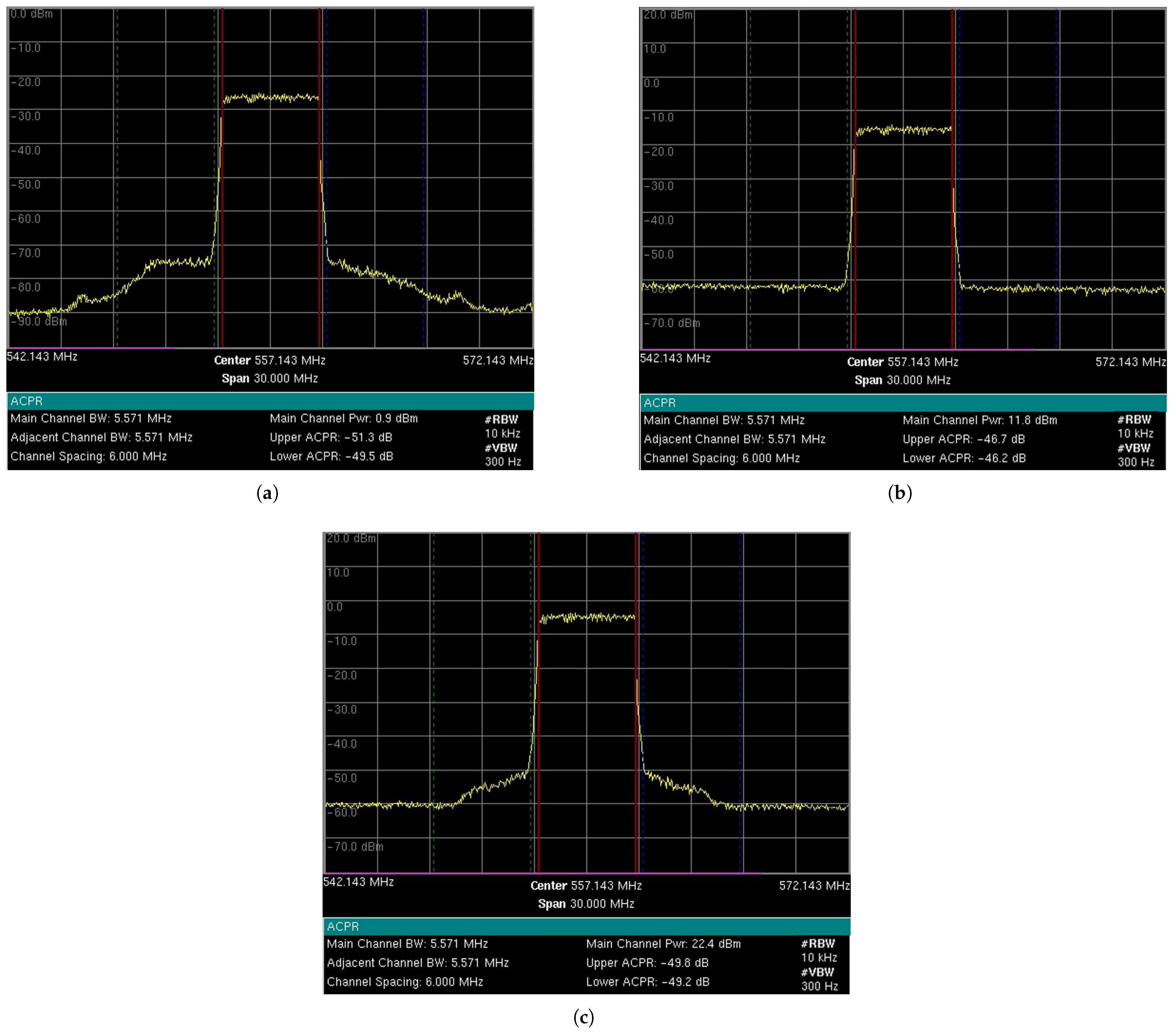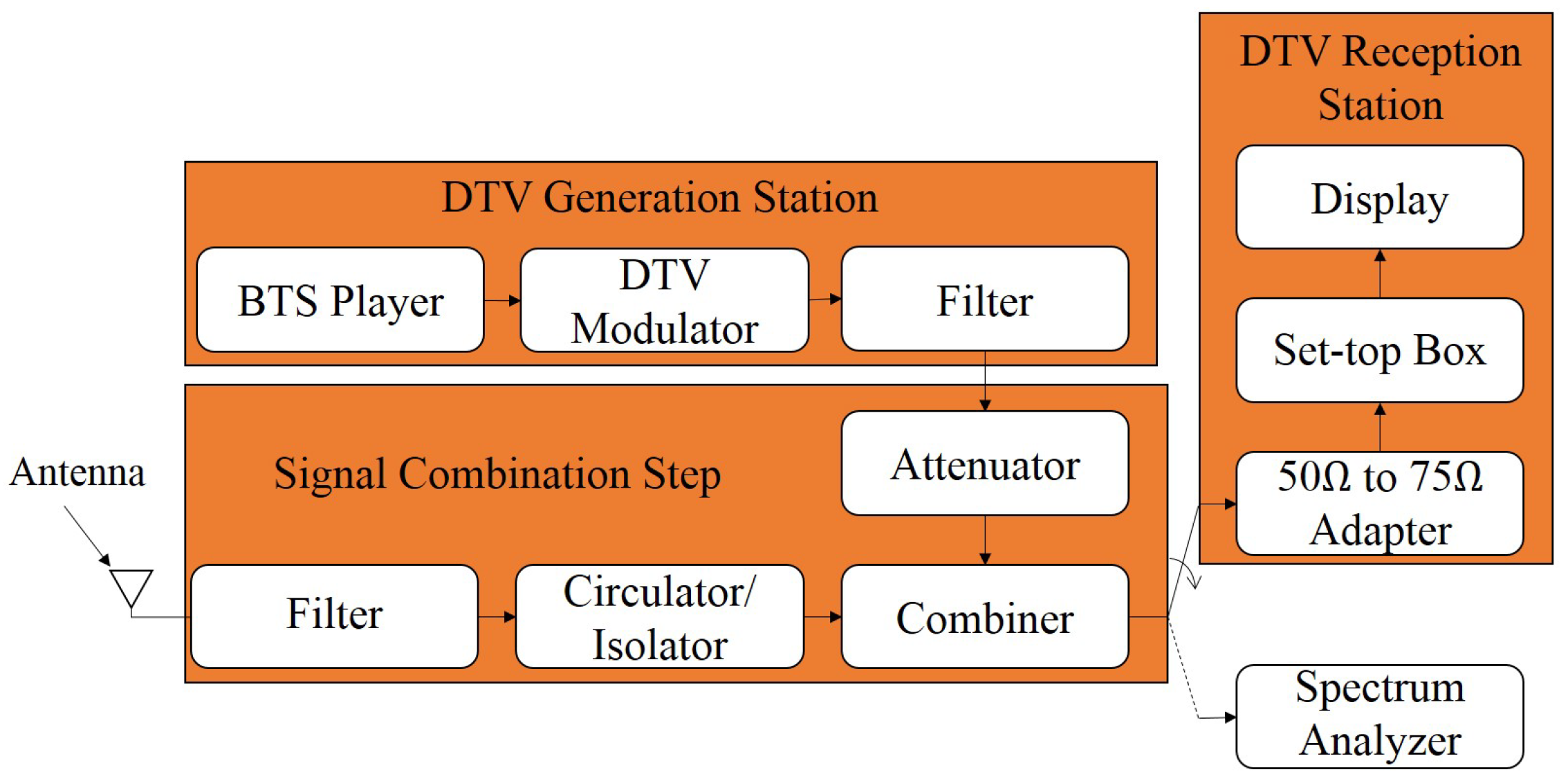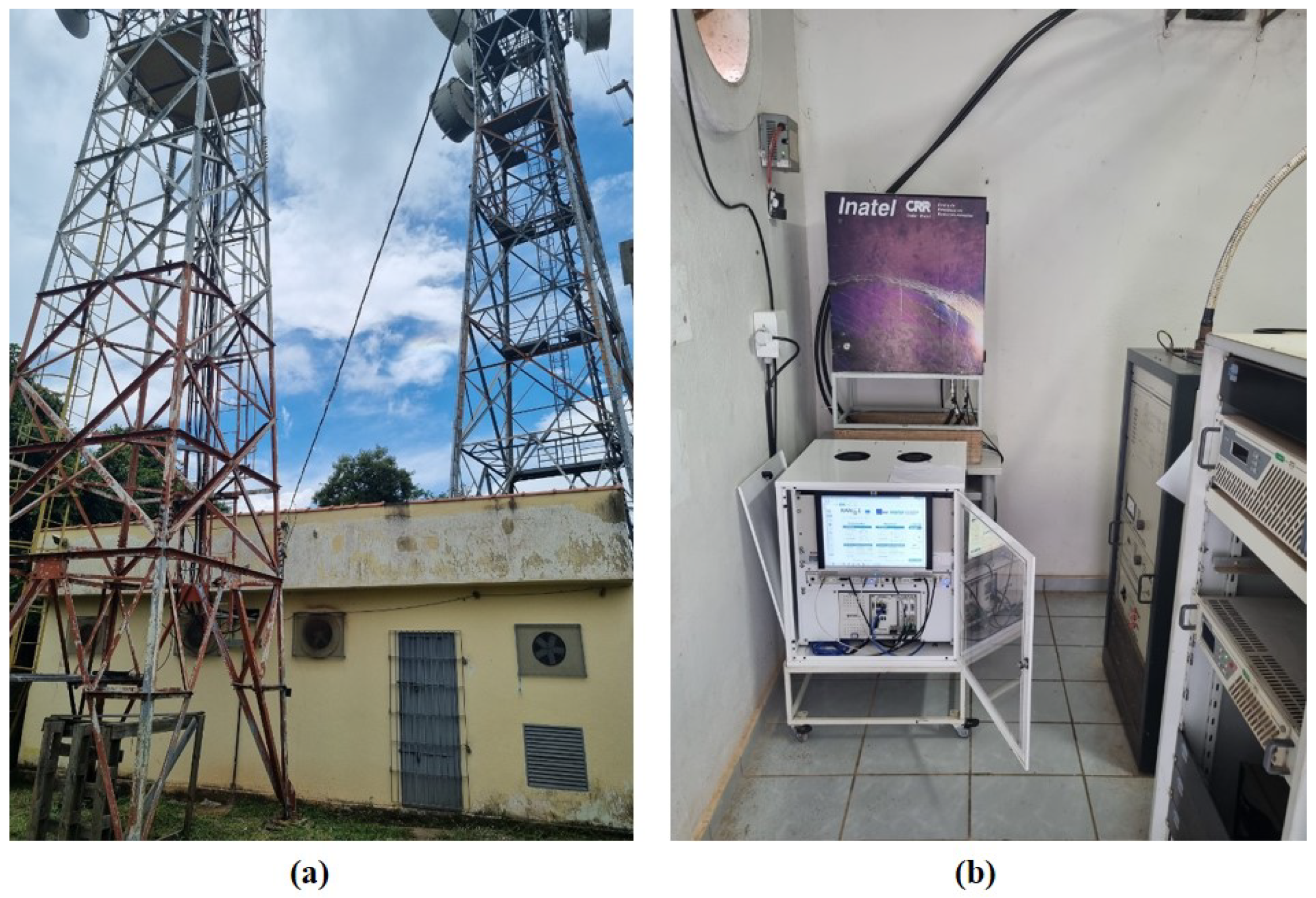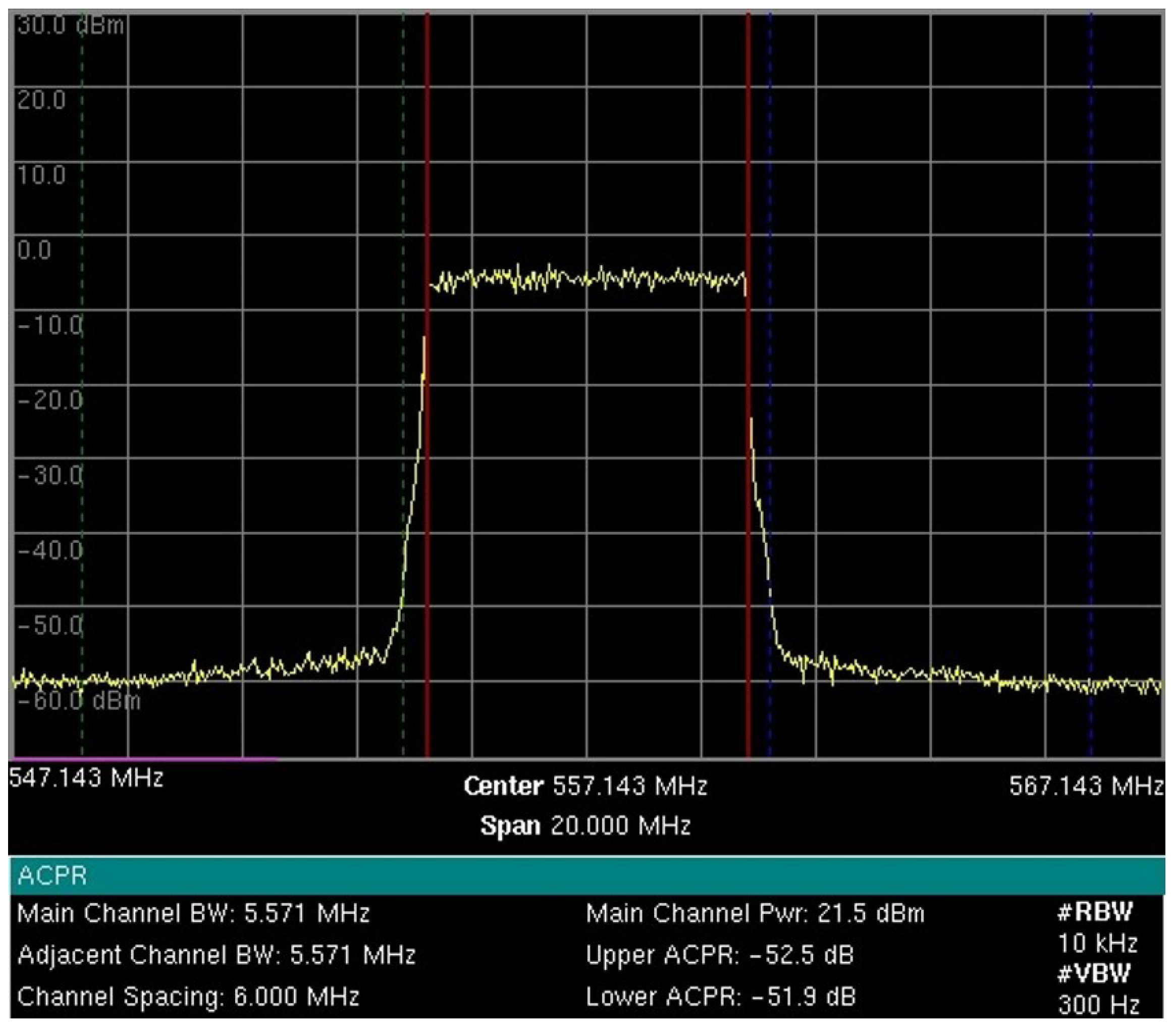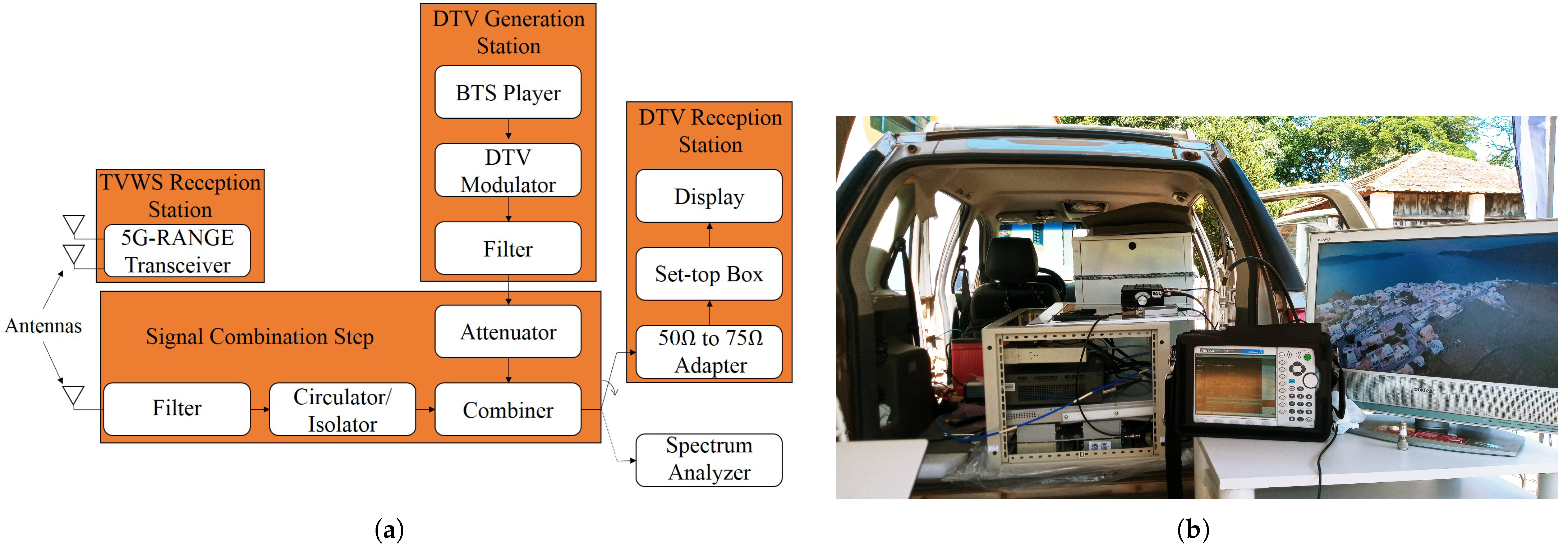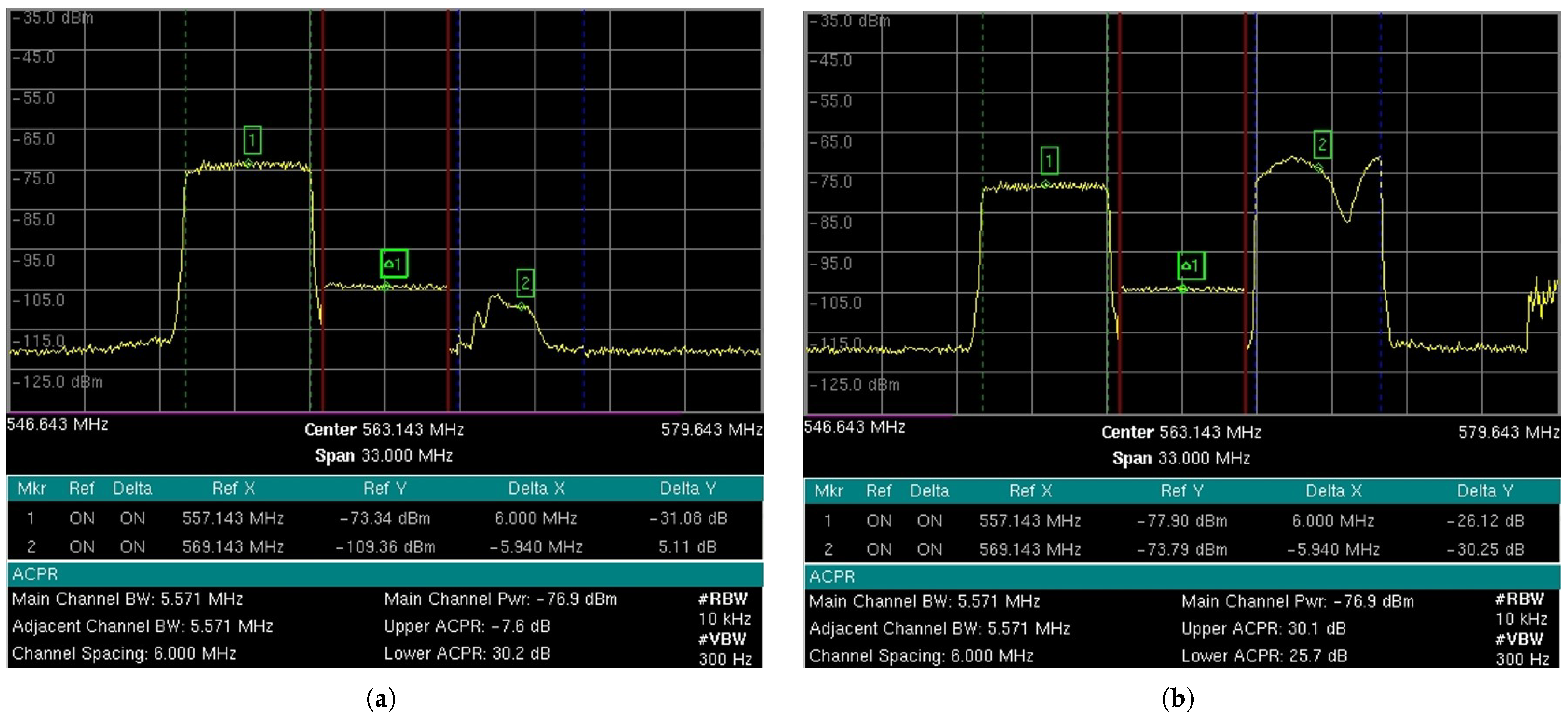1. Introduction
Brazil, being a country with continental dimensions, faces challenges related to limited broadband coverage provided by traditional operators, especially in areas far from large urban centers. Internet access and broadband communications issues act as barriers, leaving individuals in these remote and rural regions digitally excluded due to either poor or expensive services. Furthermore, the high cost of network infrastructure remains a limiting factor for digital inclusion in Brazil [
1]. In this context, TV White Space (TVWS) service has emerged as a promising alternative, using available frequencies between TV transmission channels to provide connectivity in hard-to-reach areas. TVWS technology combines its broader spectral coverage with the ability to operate at frequencies that offer greater penetration and range, making it an efficient and cost-effective solution for various applications [
2,
3]. This feature significantly reduces infrastructure investment, which is key in democratizing high-quality wireless access in Brazil, especially in rural and remote areas with limited telecommunications connectivity. Furthermore, TVWS systems show promising applications in areas such as environmental monitoring, sensor networks for precision agriculture, smart cities, and long-range IoT (LoRa) networks [
4,
5].
The use of TVWS has been widely studied as a solution to optimize spectrum usage, allowing the coexistence of multiple networks and emerging applications. The IEEE 802.22 standard, designed for cognitive networks with dynamic spectrum access, enables the efficient use of these bands, being particularly promising for vehicular communications [
6]. Furthermore, advances in spectral sensing are essential to avoid interference between different systems that share the TVWS, and strategies based on correlation and weight optimization for orthogonal frequency division multiplexing (OFDM) networks have been proposed [
7]. In the context of long-range Wi-Fi networks, the IEEE 802.11af standard has been evaluated under realistic propagation conditions, demonstrating potential for rural connectivity and IoT applications [
8]. These advances are in line with emerging trends, ranging from the increasing use of fifth-generation of cellular mobile network (5G) technology in Vehicle-to-Everything (V2X) applications for intelligent transportation systems [
9], for example, to recent research on sixth generation of cellular mobile network (6G), focusing on the integration of optical and wireless networks [
10]. These developments reinforce the need for regulation and implementation of TVWS as a viable means to expand connectivity in Brazil.
Several factors make the commercial exploitation of TVWS in Brazil challenging [
11,
12]. Observing international experiences, countries like the United Kingdom (UK), the United States of America (USA), Canada, Colombia, and South Africa, for instance, have conducted tests and implementations of TVWS. However, effective exploration of this technology is still in the early stages, partly due to restrictive regulations aimed at protecting primary users [
13,
14,
15]. Regulatory agencies have established guidelines for TVWS usage through standards from the International Telecommunication Union (ITU), the Institute of Electrical and Electronics Engineers (IEEE), and the European Telecommunications Standards Institute (ETSI). To ensure spectrum efficiency, white space device (WSDs) must implement techniques and solutions that prevent interference with primary users, such as spectral sensing and the white space database (WSDB) [
16,
17,
18]. WSDB has been established as the primary method for determining available channels in TVWS. Additionally, other parameters like out-of-band emission (OOBE) attenuation, maximum effective isotropic radiated power (EIRP), power spectral density (PSD) restrictions, and maximum height above average terrain (HAAT) for antennas, which is defined as the height at which the transmission point is above the surrounding topography, are crucial considerations in deploying TVWS services. It is worth noting that while global standardization is desired, these factors may vary according to the country and its regulatory agencies [
15,
19,
20].
The challenges in implementing TVWS, based on the literature, are significant, especially regarding spectrum availability, interference mitigation, and regulatory constraints. One of the main challenges is the accurate identification of available spectrum, as signal attenuation in indoor environments can make it difficult to detect TV white spaces, requiring advanced techniques such as sensing algorithms and geolocation databases. Another critical challenge is mitigating interference with primary services, such as digital television (DTV), particularly due to signal leakage in adjacent channels. Additionally, the spatial and temporal variation of the spectrum poses a problem, as the availability of TVWS channels can change dynamically over time and geographic location. International experience also highlights that spectral fragmentation is an obstacle, as available white spaces are not continuous, requiring flexible radios capable of operating with variable bandwidths. Moreover, the planning of real-world TVWS networks involves additional challenges, such as terrain modeling and adapting equipment to local conditions. In the regulatory context, countries like the USA, UK, Canada, Colombia, and South Africa have faced similar obstacles. While the Federal Communications Commission (FCC) in the USA and Office of Communications (Ofcom) in the UK have allowed unlicensed access to TVWS spectrum, regulation in countries like China and Singapore is still developing, exploring hybrid approaches [
3,
21,
22,
23].
The Ofcom, the UK’s communications regulator, has set the maximum EIRP parameter at 36 dBm, which aligns with the standardization by the Federal Communications Commission (FCC) in the USA. Regarding PSD restrictions, Ofcom limits power to 30 dBm over an 8 MHz bandwidth (BW), whereas the FCC specifies the same 30 dBm but over a 6 MHz BW. The BWs refer to the spectral range available for each TV channel in both countries. Concerning OOBE attenuation, the FCC has standardized an attenuation greater than
dB in adjacent channels. Conversely, Ofcom has traced distinct attenuation values based on device classes, setting a minimum attenuation of 43 dB for Class 5 devices. The HAAT parameter is defined as 250 m by the FCC, whereas Ofcom does not consider the average antenna height to the ground. The Canadian industry adheres to the definitions and standards implemented by the FCC [
21,
24,
25,
26,
27,
28].
The Agencia Nacional del Espectro (ANE) in Colombia has established a maximum output power level delivered to the antenna of 30 dBm and a maximum antenna gain of 14 dBd. The BW of TV channels in Colombia is 6 MHz, and the OOBE attenuation was defined with the same standardized values as the FCC. The maximum HAAT for antenna installation is 800 m. Lastly, the Independent Communications Authority of South Africa (ICASA) regulated parameters, especially focusing on projects using TVWS to expand internet access in rural areas. They set EIRP restrictions for each 8 MHz channel at
dBm for rural areas and 36 dBm for urban areas. As defined by Ofcom, the values for OOBE attenuations are determined according to device classes, with values greater than 43 dB for Class 5 devices and values greater than 74 dB for Class 1 devices [
29,
30,
31].
Regarding frequency bands designated for TVWS services, there is a predominant focus on standardizing frequencies in the UHF band, but this may vary from country to country. Ofcom defined frequency ranges from 470 MHz to 550 MHz and 614 MHz to 790 MHz, ANE specified frequencies between 400 MHz and 698 MHz, and ICASA standardized the frequency range from 470 MHz to 694 MHz, excluding the sub-band between 606 MHz and 614 MHz intended for Radio Astronomy. North American countries also included Very-High-Frequency (VHF) frequencies in their standardization. The United States set frequency ranges from 54 MHz to 72 MHz, 76 MHz to 88 MHz, and 174 MHz to 216 MHz for fixed WSDs, and from 470 MHz to 698 MHz for fixed and portable WSDs. Finally, Canada reserved the same frequency ranges as the FCC, excluding the sub-band from 608 MHz to 614 MHz allocated for Radio Astronomy [
25,
27,
28,
30,
31].
In Brazil, the Agência Nacional de Telecomunicações (Anatel) published a resolution that allocates frequency bands for the use of Idle Spectrum Devices, related to the TVWS regulations. The regulated frequencies resemble those defined by the FCC, excluding the bands from 76 MHz to 88 MHz and 608 MHz to 614 MHz. Another definition by Anatel is that initially, the maximum power of secondary users cannot exceed 1 W, or 30 dBm, peak, which may restrict the technology’s predictions for long-range applications. However, international studies suggest that greater flexibility in this parameter could significantly expand TVWS coverage without compromising DTV reception [
32]. Requirements for limits on OOBE and spurious components, as well as additional technical conditions for operation, are yet to be established [
33].
Among the defined parameters aimed at protecting primary users, it is noted that power limitation most directly affects current technologies in mobile communication systems, as most of these systems employ multicarrier waveforms [
34]. Modulations such as OFDM, applied in current standards like long-term evolution (LTE) [
35], LTE-Advanced (LTE-A) [
36], and 5G new radio (5G NR) [
37], for instance, were not conceived to operate in secondary networks. More recent techniques, such as filtered orthogonal frequency division multiplexing (F-OFDM) and generalized frequency division multiplexing (GFDM) may be appropriate to better meet the boundary conditions for operation in TVWS [
38,
39]. Particularly, low OOBE and the ability to control the peak-to-average power ratio (PAPR) are significant factors of interest for TVWS. The laboratory tests conducted in this paper can contribute to verifying if the regulation of using idle UHF channels for telecommunication services can ensure acceptable levels of adjacent channel leakage–power patio (ACLR) or absolute values of adjacent channel power emissions (ACPEs) while minimizing the impact of power restrictions on network coverage and capacity.
This paper presents the results of tests conducted within the scope of the project “Implementing TV White Spaces (TVWS) for Internet Access in Brazil: challenges and opportunities”, coordinated by the Brazilian Network Information Center or Núcleo de Informação e Coordenação do Ponto BR (NIC.br), and developed in collaboration with Instituto Nacional de Telecomunicações (Inatel) and the Universidade Federal do Ceará (UFC). The main objective is to evaluate the use of TVWS technology in Brazil and contribute to the process of regulation and standardization to establish an efficient and secure spectrum exploration method for broadcasters. Currently, one of the main regulatory challenges faced is the transmission power limitation of 1 Wp, which can significantly impact the feasibility of TVWS for long-range applications. Additionally, the need to ensure the harmonious coexistence of DTV and TVWS systems without mutual interference imposes technical constraints that must be experimentally evaluated. Thus, this study aims to bridge this gap through laboratory and field tests, providing concrete data to support future regulatory decisions.
The conducted studies present the conditions under which DTV and TVWS systems can coexist harmoniously, operating on adjacent channels without mutual interference. Additionally, they are expected to provide insights for establishing operational limits to make the effective implementation of TVWS networks viable in Brazil. Accordingly, this study investigates the impact of power limitation on TVWS system coverage, based on field tests conducted with the Remote Area Access Network for the Fifth Generation (5G-RANGE) system, and evaluates the necessary regulatory adjustments to ensure the viability of this technology without compromising DTV reception.
This study includes laboratory experiments related to the evaluation of the coexistence of TVWS signals with the DTV system adopted in Brazil. The DTV standard employed in the tests was integrated services digital broadcasting–terrestrial (ISDB-T) [
40], coexisting with other signals such as fourth-generation (4G) cellular mobile networks and 5G, as well as the 5G-RANGE system [
41,
42,
43,
44], specifically developed for operation in the TVWS spectrum. From the laboratory experiments, the protection ratio (PR) values between the DTV signal and interfering signals were identified, ensuring no perceptible errors in the reception and demodulation of the DTV signal. These results are fundamental for establishing technical parameters that can be used in TVWS regulation in Brazil.
Additionally, field tests were conducted considering short and long distances, aiming to complement the evaluation of the impact of Resolution No. 747 of the Anatel [
33], on the performance of this type of system and to confirm the results obtained in laboratory tests. Lastly, tests considering long distances assessed the range and throughput expected from the 5G-RANGE system when operating with 1 Watt of total peak power (Wp) delivered to the antennas, which refers to the power currently imposed on TVWS services. Long-distance tests were conducted considering Line-Of-Sight (LOS) communication to highlight the impact of transmit power limitation on maximum system coverage. This scenario enables a clearer understanding of the impact of power limitation without involving additional variables present in Non-Line-Of-Sight (NLOS) communication. The long-distance tests were conducted in a rural environment because this is the key environment considered for 5G-RANGE system conception and is the scenario considered in previous reference field tests [
45].
The results obtained in this study provide concrete evidence of the challenges and opportunities of implementing TVWS in Brazil. The tests demonstrate that, while the power limitation imposed by current regulations significantly restricts the coverage of the technology, adjustments such as relaxing this restriction could enable its adoption without compromising DTV reception. Moreover, the technical analysis based on experimental measurements allows for the proposal of technical parameters that can be adopted to improve regulations and make TVWS implementation more efficient and accessible.
This paper is systematized as follows:
Section 2 presents the conception, execution, and results of laboratory tests, defining the PRs to be observed.
Section 3 outlines the methodology used for the execution and analysis of each field test related to the coexistence tests between DTV and TVWS.
Section 4 showcases the results obtained in tests evaluating the impact of power restriction on the range and throughput in the 5G-RANGE system. Finally,
Section 5 describes the main conclusions of this paper.
2. Proposal of the New Protection Definition
This section outlines the setup and procedures for the laboratory tests, along with the achieved results. The laboratory tests aim to establish the limit parameters of protection to ensure that TVWS systems do not interfere with the DTV system.
2.1. The Methodology and the Setup Used for the Laboratory Tests
The main laboratory test goal was to identify the PR limits of DTV receivers operating under the influence of interfering signals. The PR represents the minimum value of the signal-to-interference ratio at which a specific reception quality is achieved under specific conditions. The nomenclature used to display the test results regarding the occupied channel is that the signal under analysis, namely the DTV signal, occupies channel n, while the interfering signal occupies neighboring channels to the desired channel and is identified as, for example, and , when interference is applied in the adjacent lower and upper channels, respectively. The interference applied in the second lower or upper channel is further identified as or .
In the context of coexistence with the ISDB-T standard, it is possible to mention the ITU-R BT
[
16] recommendation as a baseline reference, which provides PR values for interference in the
and
channels as
dB and
dB, respectively. This relationship was defined for the ISDB-T system operating with a BW of 6 MHz, 64-QAM modulation, and a 7/8 encoding rate, and in the presence of interference from a signal also compliant with the ISDB-T standard. It is worth noting the PR values mentioned were defined for a bit error rate (BER) of
measured before the Reed–Solomon decoder.
The methodology adopted for conducting the laboratory tests involved evaluating the PR based on a subjective analysis of the decoded DTV video signal. This evaluation aimed to determine the threshold at which interference begins to degrade the quality of the received signal, using the quasi error free (QEF) and Threshold of Visibility (TOV) criteria.
The QEF condition was established as the benchmark for distinguishing between an acceptable and a degraded signal. A signal is considered to meet QEF criteria when its decoded video is free from visually perceptible distortions, artifacts, or freezing over a 60 s observation period. The TOV is determined by progressively increasing the interfering signal level until visible artifacts, errors, or interruptions appear in the decoded video. This marks the point at which interference starts affecting reception, providing a reference for identifying the initial stage of signal degradation.
Once the TOV threshold was identified, the interfering signal was gradually attenuated in 1 dB steps until the decoded video no longer exhibited any visible artifacts. At this point, the PR was calculated by [
16,
46]
where
Pdesired is the power of the desired signal in decibel-milliwatts (dBm) and
Pinterfering is the power of the interfering signal in dBm, at which the reception was restored to a QEF condition.
Thus, the recorded measurements reflect the subjective analysis of the decoded video signal under QEF conditions, ensuring that the PR values accurately represent the interference tolerance limits of the DTV system.
Figure 1 presents the setup diagram used to carry out the laboratory tests. The setup included a DTV generation station and another generation station of different technologies, in order to generate the called interfering signals. Additionally, the setup includes amplifiers, filters, attenuators, and radiofrequency (RF) combiners.
The DTV signal was generated using a broadcast transport stream (BTS) player, model digital video recorder generator (DVRG), manufactured by Rohde & Schwarz based in Munich, Germany, along with a professional DTV modulator, model E-Compact, manufactured by Hitachi Kokusai Linear based in Santa Rita do Sapucaí, Brazil. Channel filters, model 4352 from Hitachi Kokusai Linear, were configured on channels 46, 47, 48, 49, and 50 with 6 MHz of BW. The variable attenuators used were from HP based in Palo Alto, CA, USA, whose values and models varied depending on the desired configuration during the tests. The values used were 11, 12, 70, and 120 dB, and their models are 8494A, 355C, 8495A, and 355D, respectively.
The DTV modulator was configured to operate with the following parameters:
Transmission channel UHF (674 MHz to 680 MHz);
Channel BW: MHz;
Parameters defined by the BTS flow:
Transmission mode 3;
Guard interval ;
Layer A—one segment, quadrature phase shift keying (QPSK) modulation, forward error correction (FEC) ;
Layer B—12 segments, 64 quadrature amplitude modulation (QAM), FEC .
The transmission power of the DTV system and the RF attenuator were adjusted so that the following powers were delivered to the tested set-top box (STB):
dBm,
dBm,
dBm,
dBm,
dBm,
dBm, and
dBm. It is noteworthy that the
dBm value represents the reception sensitivity threshold, and the
dBm value is the maximum recommended reception level according to the
Associação Brasileira de Normas Técnicas (ABNT) Name-Based Routing (NBR) 15604 standard [
47]. The other power levels were defined to obtain a wide range for the analysis of the behavior of the tested receivers.
The 5G-RANGE transceiver employing GFDM waveform for transmission [
43] was considered as the interfering signal generator, representing a promising TVWS solution. The main characteristics of 5G-RANGE conception are summarized in
Table 1 [
48]. The 5G-RANGE conception offers support for five different numerologies, each one with specific number of subcarriers, subcarrier spacing, Cyclic Prefix (CP) duration, and Cyclic Suffix (CS) duration. Each numerology supports a different terminal velocity and offers support for multipath protection, based on CP duration, which impacts theoretical system coverage. The modulation supported are QPSK, 16-QAM, 64-QAM, and 256-QAM. For the field tests mentioned, the adopted numerology was numerology 0, which offers support for long-distance coverage. The system conception considers a connection with a remote TVWS database to define its initial operation frequency. The TVWS database suggests channels that are not licensed for TV broadcasters. Additionally, 5G-RANGE considers the usage of the spectrum sensing algorithm, which is periodically executed to analyze the spectrum and determine if the frequency of operation in usage is really free.
In addition to 5G-RANGE, a prototype eNodeB/gNodeB generator from Inatel was used for commercial 5G NR and 4G/LTE standards. It is important to mention that the signals for 4G and 5G technologies were generated using the same hardware but with different software configurations following distinct test modes and standards. A power amplifier from the manufacturer RFHIC based in Anyang, South Korea, model RWP05040-1H, with 36 dB gain and a channel filter, were employed for each interfering signal generator to represent the real operating conditions of these systems in the field. A variable attenuator was also used to facilitate the proper adjustment of the power level at the input of the DTV receiver during the tests.
Table 2 presents the BW and power configurations of the generated interfering signals, along with their operating mode. The power value shown refers to the maximum level delivered to the input of STB. Additionally,
Figure 2 presents the measurement of the generated and characterized 5G-RANGE signal for laboratory tests. The ACLR values on channels
and
are observed to be
dB and
dB, and the ACLR on channels
and
are
dB and
dB, respectively. ACLR is the ratio, in dB, between the transmitted power in the assigned channel and the transmitted power in the adjacent channel.
Given that, in the laboratory tests, the DTV modulator was configured to transmit on the UHF channel , the interfering signal was alternately allocated in neighboring UHF channels 46, 47, 49, and 50, referred to as interference on channels , , , and , respectively.
The outputs of the variable attenuators of the DTV and interfering signal generation are combined to occupy the same medium and transmission spectrum. They are then divided by an RF splitter to allow simultaneous analysis of the combined signals. The first output of the RF splitter is connected to the input of the DTV reception station, where there is a 50 -to-75 impedance adapter, commercial DTV receivers (STBs), and the display for video visualization. STBs from three different manufacturers were used, employing Silicon Tuner technology, including two commercial ones and one fabricated and donated to families participating in the Brazilian government program called “Bolsa Família”. The second output of the RF splitter is connected to the spectrum analyzer, model MXA N9020A signal analyzer, manufactured by Agilent. The power level measurements of the DTV signal and the interfering signal were performed using the mentioned spectrum analyzer in adjacent channel power (ACP) mode, with a resolution bandwidth (RBW) of 10 kHz, a video bandwidth (VBW) of 300 Hz, and a span of 30 MHz, while the center frequency depended on the channel being analyzed.
2.2. Main Results Achieved
The results obtained from the laboratory tests were condensed into several curves, which are presented and described below.
Figure 3 depicts curves that relate the DTV signal power to the average PR obtained for the demodulation and decoding of the video signal without visually perceptible issues. Therefore, the PR value presented is the limit value for harmonious coexistence, according to the aforementioned criterion. Each curve on the graph represents the mean PR value, named as the PR
avg value, obtained for the three evaluated receivers. Each curves is related to the influence of one interfering signal at a time, generated by one of the three different systems described: 4G, 5G, or 5G-RANGE in GFDM.
Figure 3a illustrates the DTV signal power versus PR
avg curve for a non-simultaneous interfering signal applied to the immediately lower or upper adjacent channels, i.e., interference on channel
or
. It can be observed that for the DTV signal with a power lower than
dBm, the average PR value for different technologies, considering the incidence of interference in one of the adjacent channels, is around
dB. In other words, the DTV signal can be correctly demodulated even in the presence of an interfering signal in an adjacent channel with a power around 30 dB higher than the DTV signal. However, for DTV power levels higher than
dBm, the PR value must be higher than the mentioned value, implying a lower power of the interfering signal. The highest PR
avg value identified was approximately
dB for the DTV power of
dBm when the interfering signal was the 5G NR signal on channel
. Additionally, it is observed that the lowest PR
avg values for interference on channels
and
are achieved with 5G-RANGE in GFDM as the interferer, highlighting its low OOBE.
Since the received power of the DTV signal in real conditions is typically reduced due to the distance between the receivers and transmission stations, it is worth noting the PR
avg values obtained for the DTV signal power of
dBm, which is the recommended sensitivity threshold for DTV receivers [
47]. The lowest PR
avg values for interference on channels
and
are
dB and
dB, respectively, both achieved with 5G-RANGE in GFDM as the interfering signal. On the other hand, the highest PR
avg values were measured for the 4G/LTE and 5G NR technologies, which were
dB for channel interference
and
dB for channel interference
.
Figure 3b shows the DTV signal power versus PR
avg curve for a non-simultaneous interfering signal applied to the second lower or upper adjacent channel, i.e., interference on channel
or
. It can be observed that for the DTV signal with a power lower than
dBm, the average PR value for different technologies, considering the incidence of an interfering signal, is around
dB. In other words, the DTV signal can be correctly demodulated even in the presence of an interfering signal in the second adjacent channel with a power level around
dB higher than the DTV signal. However, the PR value must be higher than the mentioned value for DTV power levels higher than
dBm. The highest PR average identified was approximately
dB, for the DTV power of
dBm when the 5G NR and 4G/LTE signals were the interfering signals in the channel
.
Similarly to the analysis performed under interference conditions and , for the received DTV power of dBm, the lowest PRavg values for interference on channels and were dB and dB, achieved with the 4G/LTE technology and the 5G-RANGE transceiver using GFDM, respectively. The highest values were also obtained with the same technologies, with 5G-RANGE as the interfering signal on channel with a PRavg of dB and 4G/LTE technology as the interfering signal on channel with a PRavg of dB.
Additionally, during the test campaign, the PR was investigated in scenarios where it had two neighboring channels simultaneously around the DTV channel. For this, there was an adjustment in the test setup, including another interfering signal generation station, and combining the outputs of the variable attenuators of each one to work with two interfering signals. In these tests, signals 4G and 5G-RANGE in GFDM were used on channels
and
, respectively.
Table 3 shows the results of laboratory tests considering the incidence of two interfering signals simultaneously on channels
and
. A 3 dB increase in the PR value is observed compared to the incidence of only one of the interferences at a time.
4. Power Restriction Impact in the 5G-RANGE as TVWS System
The results presented in this section refer to the second stage of field tests, considering long distances, and investigate the impact of the transmission power limitation applicable to TVWS systems on coverage and link quality. The secondary network is the 5G-RANGE system, and the tests consider a total transmission power (
PTX) restriction of 1 Wp delivered to the transmission antenna, for a transmission channel with a 6 MHz BW, based on Anatel’s resolution [
33].
As a key reference parameter for analyzing the impact of power limitation on 5G-RANGE coverage, previous field tests were conducted when no power limitation was defined, as detailed in [
45]. The channel BW used in previous and reference tests was 24 MHz, and the
PTX, considering a PAPR of 10 dB, was approximately
dBm or
Wp. With these configurations, the system operated with a throughput of 102 Mbps over a link distance of 50 km. It is worth noting that this was not the maximum coverage limit of the system under the described conditions. In the reference test, the goal was to verify long-range coverage while maintaining support for a throughput of 100 Mbps.
Table 11 presents the results of field tests related to the 5G-RANGE system operating under the current restrictions imposed on TVWS systems. The measurements were performed at locations closest to the BS, specifically at MS_Loteamento and MS_DeltaBlack, with straight-line distances from the MS of
km and
km, respectively. In both links, it was possible to establish reception with a modulation and coding scheme (MCS) configuration that provides the maximum data throughput supported by the system. This configuration involves using the 256-QAM mapping scheme and employs Polar FEC encoding with a coding rate of
. Consequently, a bitrate of 30 Mbps was achieved for a channel with a BW of 6 MHz.
It is important to emphasize that the criterion used for selecting the configured MCS at each location is related to achieving a BER of 0, measured and observed within a time interval of 5 s after resetting the system. Extrapolating to a transmission using four UHF channels, totaling a BW of 24 MHz, which is the maximum BW supported by the 5G-RANGE system, the MCS provides support for communication with a bitrate
4 Ch of 120 Mbps. Additionally, in
Table 11, the received power (
PRX Ant.) captured by one of the system’s antennas and the signal-to-noise ratio (SNR) values are observed.
The results of the field measurements at the location referred to as “MS_CafezalManoela”, establishing a communication link with a distance of
km to the BS, are presented in
Table 12. Tests were conducted at this location considering the BS configured to transmit, in addition to the initial
PTX of 1 Wp, power levels of 2 Wp and 4 Wp, since the initial
PTX did not provide the system with full operational capacity. However, the 1 Wp
PTX enabled the system to operate with an MCS featuring 256-QAM mapping and Polar code
, providing support for a bitrate of 24 Mbps for the system operating with a 6 MHz BW. Considering a BW of 24 MHz, the bitrate
4 Ch of the system amounts to 96 Mbps, a value close to that obtained in the reference test of 5G-RANGE. Therefore, it is estimated that the maximum distance for the system to achieve a throughput of approximately 100 Mbps, for a 1 Wp
PTX, is
km. Increasing the transmission power to 2 Wp and 4 Wp allowed the system to operate at the “MS_CafezalManoela” location with the MCS providing the highest throughput in the system, namely, 120 Mbps.
Table 13 presents the results of the tests conducted at the most distant location, which is at a straight-line distance of
km from the BS, referred to as “MS_Pedralva”. At this location, it was possible to establish a reception link using QPSK mapping and Polar code with a
rate in the 5G-RANGE system, for a
PTX of 1 Wp. This configuration supports a throughput of 4 Mbps for a transmission channel with a 6 MHz BW or 16 Mbps for a channel with a 24 MHz BW. Additionally, since this configuration provides the lowest MCS and the minimum throughput supported by the 5G-RANGE system, it can be concluded that, at the “MS_Pedralva” location, the system operated at the coverage edge for the configured 1 Wp
PTX, which is the currently applicable transmission power limit for TVWS systems.
Tests were executed by increasing the total transmission power to 2 Wp, 4 Wp, and additionally, 8 Wp. Under these conditions, it was possible to achieve a communication link supporting a throughput4 Ch of 28 Mbps, 48 Mbps, and 52 Mbps, respectively. This represents an increase equivalent to times, 3 times, and times, respectively, compared to the throughput supported with 1 Wp. The results of these tests showed that, for applications in rural areas, the power limitation imposed on TVWS may restrict coverage, which reinforces the need for regulatory adjustments that consider not only the protection of DTV, but also the viability of TVWS for long-distance communication.
Figure 14d shows the MS at the “MS_Pedralva” location during the field tests, and
Figure 14a–c illustrates the reception spectrum at the locations “MS_DeltaBlack”, “MS_CafezalManoela”, and “MS_Pedralva” for the BS operating with a power of 1 Wp. The
PRX Ant. values are shown with a 6 MHz BW of the received signal. Additionally, there is an inset of the constellation corresponding to the modulation configuration achieved for each location.
5. Conclusions
This paper, inserted in the context of the project “Implementing TV White Spaces for Internet Access in Brazil”, provided essential information to support the implementation of TVWS technology in Brazil. This included evaluating the harmonious coexistence between DTV and TVWS systems, as well as investigating operational limits to enable the effective development of new TVWS services. Additionally, it consolidated and compared the results of practical tests examining the coexistence between DTV and TVWS signals used as interference and allocated on channels , , , and conducted in laboratory and field environments, covering different distances.
Laboratory tests involved assessments on the bench and in a controlled environment, analyzing power curves of DTV versus PRavg. The results evidenced that the PR varies according to the interfering technology and the spectral positioning of the TVWS signal to the DTV. The lowest PR recorded was −33.24 dB for 5G-RANGE in GFDM on channel , indicating low OOBE and less impact on DTV reception. The highest PR observed was −25.85 dB for 5G NR on channel , demonstrating a greater potential for interference. In addition, it was found that the simultaneous presence of interferers on channels and resulted in an average increase of 3 dB in PR, reinforcing that multiple sources of interference can significantly affect DTV reception. Overall, the results demonstrated that the TVWS signal power could be significantly higher than that of DTV without causing perceptual and visible artifacts or errors on decoded video.
Field tests at short distances confirmed these conclusions, highlighting the effective transmission capability of TVWS and that the spectral position of the interference and the receiver model significantly influence the PR. In these tests, it was evident that the performance of the receivers also varied significantly when analyzing the interference on channels and . STB 1 presented a PR approximately 10 dB higher than the other models, indicating a lower capacity to reject interference. In other words, STBs 2 and 3 demonstrated greater resilience, supporting interfering signals with up to 10 times higher power in and .
Furthermore, long-distance tests revealed that increasing the TVWS power to up to four times the regulated level (6 dB above the regulatory limit) did not disrupt DTV signals. This result indicates that adjustments in the regulation could allow greater flexibility without compromising digital television reception. The results highlighted that the current regulatory power limitation, set at 1 Wp, compromises the coverage range, particularly in applications that require long distances. Compared to previous tests, which aimed to verify long-range coverage while maintaining support for a throughput of 100 Mbps and in which there were no power restrictions, the system was able to achieve 102 Mbps at 50 km distance with 120.2 Wp, demonstrating that with higher power, it is possible to provide reliable connectivity for large regions. In contrast, the current tests showed that with 1 Wp, the maximum throughput was 96 Mbps at 14.7 km from the base station, while increases to 2 Wp and 4 Wp made it possible to reach 120 Mbps. In the most extreme scenario, at MS_Pedralva (38.34 km from the BS), the system operated at its limit with 1 Wp, reaching a throughput of only 16 Mbps for a 24 MHz BW. However, increasing the power to 8 Wp allowed for a tripling of the throughput.
It is important to highlight that the long-distance tests were conducted considering LOS communication to highlight the impact of transmission power limitation on the maximum coverage of the system. In this scenario, it was possible to understand the effects of power restriction more clearly, eliminating additional variables of NLOS communication. The tests were carried out in a rural environment, as this is the key scenario for 5G-RANGE, and is also the basis of previous tests used as a reference. The analysis of the tests shows that, in open-field scenarios, the technology can reach greater distances with higher powers, while in urban and mountainous areas, propagation could probably be affected by physical and topographical barriers. However, tests in scenarios other than LOS communication were not carried out. Therefore, it is not known for sure what the implications of the regulation would be in NLOS conditions, where natural and artificial obstacles could significantly impact signal propagation, and, therefore, power limitation could be even more detrimental to TVWS services.
The potential for practical application of TVWS in the remote and rural areas of Brazil is significant, especially for expanding internet access in low-density regions where traditional telecommunications infrastructure is limited or non-existent. By offering long-range, low-cost connectivity, TVWS has enormous potential to enable everything from essential services, such as health and education, to advanced applications, such as smart agriculture and public safety, with remote sensing applications for precision agriculture, connectivity for autonomous agricultural machinery, and video surveillance for rural security, among others. These results reinforce that regulatory adjustments, such as a controlled increase in the power limit and optimization of OOBEs, could significantly expand the potential use of the technology. By limiting OOBEs, the regulation would allow the adoption of more efficient modulation techniques in terms of spectral allocation, which could serve as technological differentiators between different standards and equipment manufacturers. Finally, imposing stricter requirements on DTV receivers can ensure greater robustness to interference, enabling more efficient use of the spectrum without compromising the quality of television broadcasting. In any case, it is important to emphasize that, even with current restrictions, TVWS networks can offer high-quality services and robust support for various applications in rural and remote areas.
Future work may explore analyses in urban, mountainous, and densely vegetated environments, where signal propagation can be significantly affected by physical obstacles and multipath reflections, to broaden the understanding of the feasibility of TVWS in different scenarios. Tests in NLOS conditions will allow us to evaluate how power restriction impacts coverage and signal quality in situations where there is no direct line of sight between transmitter and receiver.
This work contributes substantially to the technical and regulatory understanding of TVWS technology in Brazil, providing a solid foundation for the development of public policies and industrial standards that encourage its adoption. With these guidelines, TVWS systems are expected to play a crucial role in the digital transformation of rural and urban areas, promoting digital inclusion, environmental sustainability, and the advancement of smart networks.
